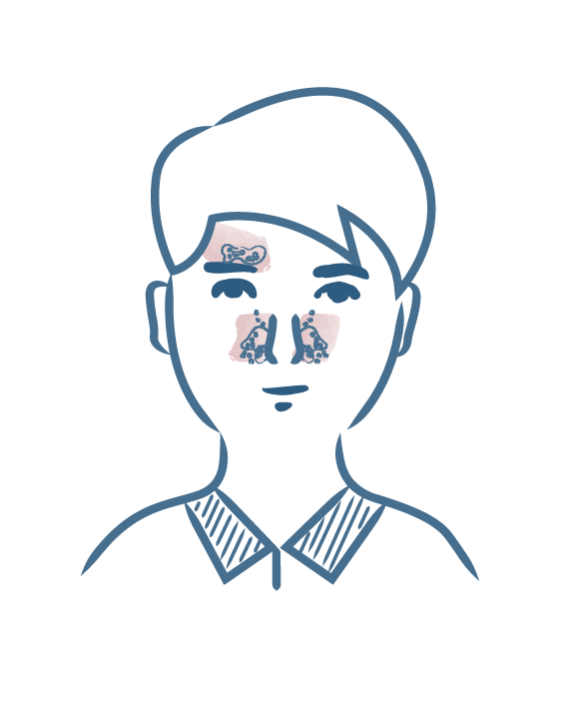
The causes of seborrheic dermatitis
Seborrheic dermatitis is a common condition that affects between 1 and 3% of the French population during adolescence and adulthood. It is most common between the ages of 18 and 40, with men far more frequently affected than women (with six men affected for every woman). There are three causes (or physiopathological mechanisms) of the disease which are now well known. Various other factors that can aggravate seborrheic dermatitis or trigger a flare-up have also been identified, including stress, fatigue and overwork.
3 factors identified as causing seborrheic dermatitis
We now know the causes(1) of seborrheic dermatitis, but scientists disagree on their chronological progression and on how they are interrelated. Three factors have been identified:
- sebum, in large quantities such as in so-called oily areas,
- the proliferation of a yeast of the Malassezia genus,
- and skin inflammation.
In people with seborrheic dermatitis, in the so-called oily areas in which sebum accumulates, a yeast of the Malassezia genus is able to proliferate abnormally.
This yeast is naturally present on the surface of the skin and is part of the skin microbiome.
When it proliferates, it triggers a specific inflammatory reaction, resulting in redness and accelerated renewal of scalp and skin cells. This erythema, accompanied by small scales on the surface of the skin, is characteristic of seborrheic dermatitis.
The aggravating factors of seborrheic dermatitis
Many external and internal factors can aggravate the disease or trigger a flare-up of seborrheic dermatitis:
- External factors:
o Climatic factors: humidity, cold
o Perspiration
o Excessive application of greasy substances to the skin
o Alcohol and tobacco consumption
o Diet is also thought to play a role in the development of lesions(2)
o Stress
- Internal factors
o Individual predispositions: obesity, hyperhidrosis, etc.
o Hormonal disorders can influence seborrhea and disrupt immunity
o Episodes of stress and fatigue
o Other factors Seborrheic dermatitis may be caused by stress, which can affect all organs, especially the skin, and have an impact on sebum secretion, inflammation and immunity.
Seborrheic dermatitis and other diseases
An incidence of seborrheic dermatitis has been observed in patients suffering from immune system deregulation, such as HIV patients. Seborrheic dermatitis is frequently observed at the time of diagnosis of HIV and usually disappears as soon as antiretroviral treatment is started (2).
Seborrheic dermatitis is also observed in patients suffering from Parkinson's disease, as the decrease in dopamine levels leads to a disturbance in sebum production and a change in its composition.
Certain psychiatric conditions may also promote the development of seborrheic dermatitis.
Although the deficiencies caused by these diseases may increase the risk of developing seborrheic dermatitis, this in no way means that seborrheic dermatitis itself implies a risk of developing a serious disease. In fact, people with these diseases represent only a minority of those affected by seborrheic dermatitis, which occurs most frequently in healthy people (4).
(1) De Angelis YM, Gemmer CM, Kaczvinsky JR, Kenneally DC, Schwartz JR, Dawson TL. Three etiologic facets of dandruff and seborrheic dermatitis: Malassezia fungi, sebaceous lipids, and individual sensitivity. Journal of Investigative Dermatology Symposium Proceedings. (December 2005), Vol. 10, 3, pp. 295-297. (2) 40. Szepietowski JC, Reich A, Wesołowska-Szepietowska E, Baran E. Quality of life in patients suffering from seborrheic dermatitis: influence of age, gender and education level. Mycoses. (2009), Vol. 52, 4, pp. 357-363. (3) Bittencourt Sampaio ALS. Seborrheic dermatitis. Anais Brasileiros de Dermatologia. (nov/dec 2011), Vol. 86, 6. (4) Gary W. Clark|Sara M. Pope|Khalid A. Jaboori, Diagnosis and Treatment of Seborrheic Dermatitis – American Family Physician, www.aafp.org (consulted on July 7, 2016)
Our care routines
Irritated skin with redness and scales

